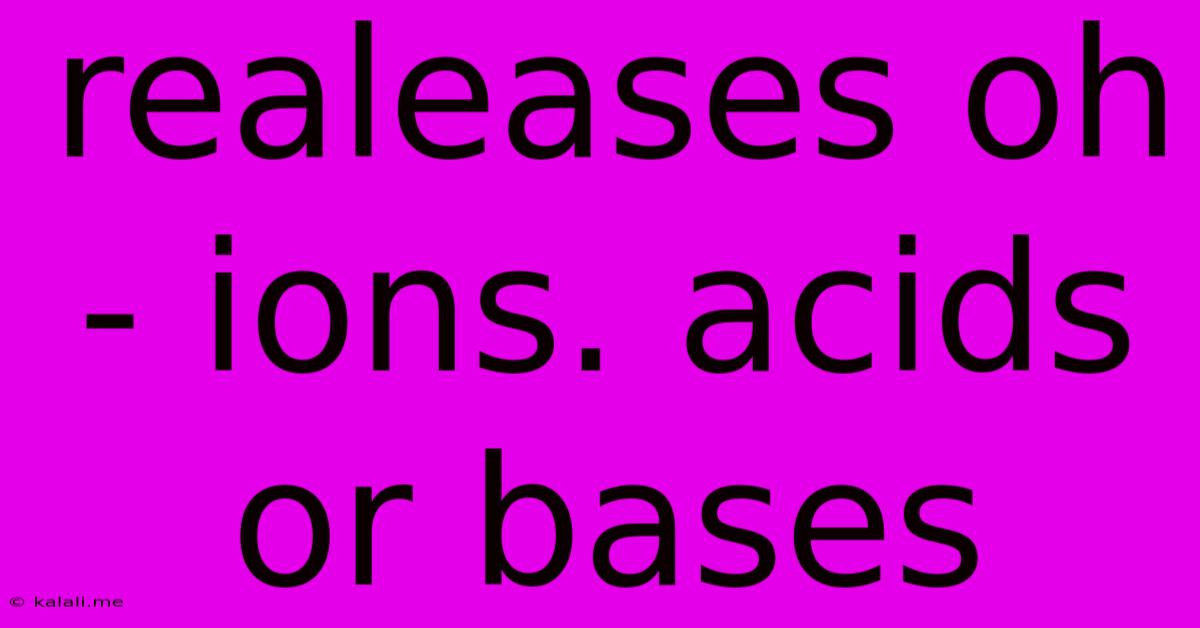Realeases Oh - Ions. Acids Or Bases
Kalali
Jun 03, 2025 · 3 min read

Table of Contents
The Release of H⁺ Ions: Acids and Bases Explained
This article delves into the fundamental concept of hydrogen ion (H⁺) release and its crucial role in defining acids and bases. We'll explore the different theories surrounding acid-base chemistry, clarifying the nuances and providing a comprehensive understanding of this critical aspect of chemistry. Understanding the release of H⁺ ions is key to comprehending various chemical reactions and their implications in different fields, from everyday life to advanced scientific research.
What are Acids and Bases?
At its core, the concept of acids and bases revolves around the transfer of protons (H⁺ ions). While several theories exist, the most common are the Arrhenius, Brønsted-Lowry, and Lewis theories. Let's examine them in relation to H⁺ ion release:
Arrhenius Theory: A Simple Definition
The Arrhenius theory provides a simple definition: acids are substances that release H⁺ ions (protons) when dissolved in water, while bases release hydroxide ions (OH⁻) in water. This theory focuses solely on aqueous solutions. For example, hydrochloric acid (HCl) dissociates in water to produce H⁺ and Cl⁻ ions:
HCl(aq) → H⁺(aq) + Cl⁻(aq)
This straightforward approach is useful for understanding basic acid-base reactions but lacks the breadth to explain all acid-base interactions.
Brønsted-Lowry Theory: A Broader Perspective
The Brønsted-Lowry theory offers a more comprehensive view. It defines acids as proton donors and bases as proton acceptors. This theory extends beyond aqueous solutions, encompassing reactions in other solvents or even gas phases. The focus is on the proton transfer itself, rather than the specific ions produced.
For instance, in the reaction between HCl and water:
HCl(aq) + H₂O(l) → H₃O⁺(aq) + Cl⁻(aq)
HCl acts as a Brønsted-Lowry acid, donating a proton to water, which acts as a Brønsted-Lowry base. Note that the H⁺ ion doesn't exist freely in solution; it readily bonds with a water molecule to form a hydronium ion (H₃O⁺). This is a more accurate representation of the proton in aqueous solutions.
Lewis Theory: The Electron Pair Perspective
The Lewis theory takes a different approach, focusing on electron pairs. A Lewis acid is defined as an electron pair acceptor, while a Lewis base is an electron pair donor. While not directly related to H⁺ ion release, it's important to note that many Brønsted-Lowry acids also function as Lewis acids because they can accept electron pairs from the base. This theory expands the definition further to encompass reactions that don't involve protons.
The Strength of Acids and the Extent of H⁺ Ion Release:
The amount of H⁺ ions released by an acid determines its strength. Strong acids completely dissociate in water, releasing all their protons. Examples include HCl, HBr, and HNO₃. Weak acids, on the other hand, only partially dissociate, releasing only a small fraction of their protons. Acetic acid (CH₃COOH) is a common example of a weak acid. The equilibrium between the undissociated acid and its ions dictates the extent of H⁺ release.
Conclusion:
The release of H⁺ ions is a central concept in understanding acids and bases. While the Arrhenius theory provides a simple introduction, the Brønsted-Lowry and Lewis theories offer broader and more nuanced perspectives. The strength of an acid is directly linked to the extent of H⁺ ion release, influencing its reactivity and behavior in chemical reactions. Understanding these concepts is fundamental to various branches of chemistry and related fields.
Latest Posts
Latest Posts
-
Why Did Harry Try To Kill Bullock
Jun 05, 2025
-
Furnace Needs To Be Reset Often
Jun 05, 2025
-
Bash Assign Associative Array To Ordered Pairs
Jun 05, 2025
-
How To Say Walnut In Spanish
Jun 05, 2025
-
How To Fish In Lava In Terraria
Jun 05, 2025
Related Post
Thank you for visiting our website which covers about Realeases Oh - Ions. Acids Or Bases . We hope the information provided has been useful to you. Feel free to contact us if you have any questions or need further assistance. See you next time and don't miss to bookmark.